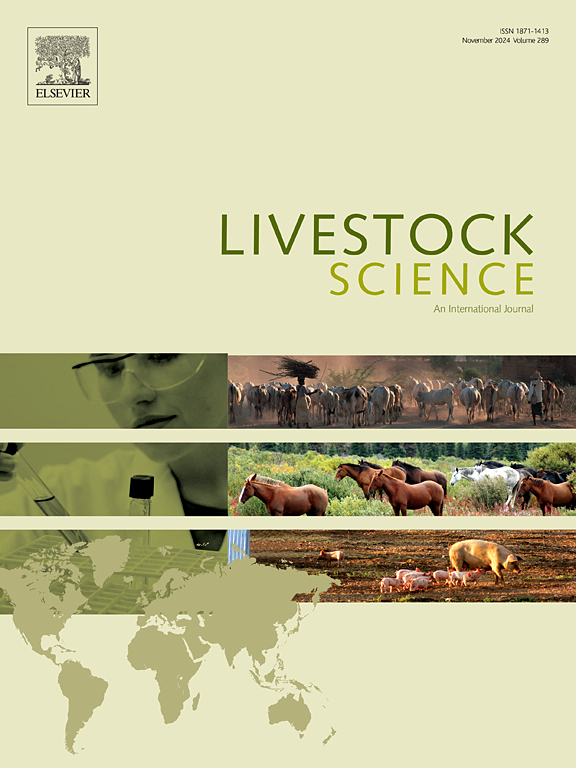Methane and nitrous oxide emissions from excreta of different beef cattle breeds fed with different concentrate:roughage ratios and finished in feedlots under tropical conditions
IF 1.9
3区 农林科学
Q2 AGRICULTURE, DAIRY & ANIMAL SCIENCE
引用次数: 0
Abstract
Excreta from confined beef cattle are sources of greenhouse gas (GHG) emissions; however, little is known about the effects of different concentrate:roughage ratios and cattle breeds on these emissions. This study evaluates methane (CH4) and nitrous oxide (N2O) emissions from the excreta of Nellore or crossbred (Nellore × Angus) beef cattle that are fed diets containing 65% or 85% of concentrates under tropical conditions. The excreta were applied to the floor of feedlot pens, and N2O and CH4 emission rates were monitored for 84 days in static chambers. The animals were confined for 106 days to evaluate their intake, weight gain and feed efficiency. In addition to average emission rates, emissions from excreta were estimated based on ratios per kg of dry matter intake (DMI; CH4/DMI and N2O/DMI) and per kg of weight gain (average daily weight gain, ADG; CH4/ADG and N2O/ADG). The data were subjected to variance analysis in a 2 × 2 factorial arrangement, and the means were compared using a Tukey test (P < 0.05). Results indicated that CH4 emissions were 2.40 times higher from the excreta of crossbred cattle than in Nellore cattle (P < 0.039). N2O emissions were 50.1% lower from the excreta of animals consuming diets with low concentrate:roughage ratios than in those consuming diets with high concentrate:roughage ratios. The CH4/DMI and CH4/ADG ratios were higher in the excreta of crossbred cattle than in Nellore cattle. The N2O/ADG and N2O/DMI ratios in the excreta of animals fed with high concentrate:roughage ratios were also 18.2% and 36.1% higher in crossbred cattle than in Nellore cattle. The N2O/DMI and N2O/ADG ratios in the excreta of crossbred and Nellore cattle were lower when fed with diets containing low compared to high concentrate:roughage ratios. The results suggest that crossbred animals with more concentrate feed diets emit more CH4 and N2O from their excreta. This is the first study to report that Nellore cattle, the predominant breed in Brazil, and diets with lower concentrate:roughage ratios may be associated with a reduced potential for GHG emissions from excreta in confined beef cattle under tropical conditions.
不同肉牛品种在热带条件下以不同精料和粗料比例饲养并在饲养场育成的排泄物中产生的甲烷和氧化亚氮排放
圈养肉牛的排泄物是温室气体排放的来源;然而,人们对不同的精料比和牛品种对这些排放的影响知之甚少。本研究评估了热带条件下饲粮中添加65%或85%精料的Nellore肉牛或杂交(Nellore × Angus)肉牛排泄物中甲烷(CH4)和氧化亚氮(N2O)的排放。将粪便施用于饲养场围栏地面,在静室中监测N2O和CH4排放率84 d。饲养106 d,评价采食量、增重和饲料效率。除平均排放率外,排泄物排放率是根据每千克干物质摄入量(DMI;CH4/DMI和N2O/DMI)和每公斤增重(平均日增重,ADG;CH4/ADG和N2O/ADG)。数据采用2 × 2因子排列进行方差分析,均数采用Tukey检验(P <;0.05)。结果表明,杂交牛粪便中CH4的排放量是内洛牛的2.40倍(P <;0.039)。低精粗比饲粮的动物排泄物N2O排放量比高精粗比饲粮的动物低50.1%。杂交牛粪便中CH4/DMI和CH4/ADG比值高于内洛牛。高精粗比饲喂的杂交牛排泄物中N2O/ADG和N2O/DMI比值也分别比尼洛尔牛高18.2%和36.1%。饲粮中精粗比较低时,杂交牛和耐洛牛排泄物中N2O/DMI和N2O/ADG比值较低。综上所述,饲粮精料含量越高,杂交动物粪便中CH4和N2O排放越高。这是第一个研究报告,在热带条件下,巴西的优势品种Nellore牛和较低精料比的日粮可能与减少限制肉牛排泄物温室气体排放的潜力有关。
本文章由计算机程序翻译,如有差异,请以英文原文为准。
求助全文
约1分钟内获得全文
求助全文
来源期刊

Livestock Science
农林科学-奶制品与动物科学
CiteScore
4.30
自引率
5.60%
发文量
237
审稿时长
3 months
期刊介绍:
Livestock Science promotes the sound development of the livestock sector by publishing original, peer-reviewed research and review articles covering all aspects of this broad field. The journal welcomes submissions on the avant-garde areas of animal genetics, breeding, growth, reproduction, nutrition, physiology, and behaviour in addition to genetic resources, welfare, ethics, health, management and production systems. The high-quality content of this journal reflects the truly international nature of this broad area of research.
 求助内容:
求助内容: 应助结果提醒方式:
应助结果提醒方式:


